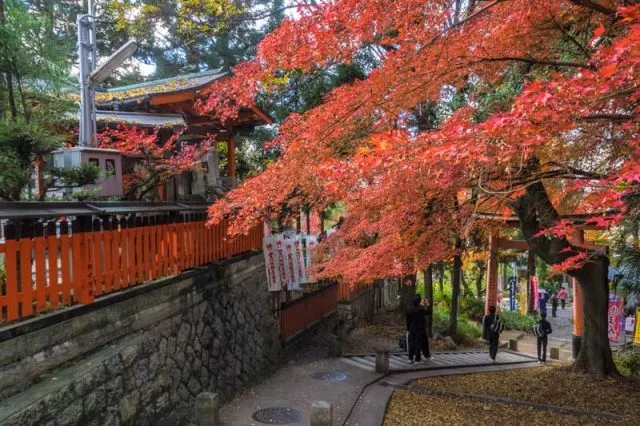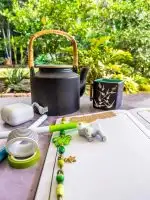
Seasons are a highlight of travelling in Japan and the perfect time to experience the Golden Route from Osaka to Tokyo. Autumn in Japan brings colourful leaves known locally as Koyo, seasonal foods and many unique experiences discovering parks, gardens, temples and natural mountain regions.
We’d planned out a circuit for autumn leaves in Japan a few years ago but for a number of reasons the timing just didn’t work out. Fate stepped in last year and everything fell into place for us to head away in November for a few weeks so I got to work pulling together an itinerary.
Table of Contents
What is Japans Golden Route?
While we love exploring Japans smaller cities and less travelled paths and will continue to do so on future visits, the Golden Route bears its name and popularity with both international and domestic travellers for a very good reason. It’s a stunning part of the country, it offers a diverse range of scenery and experiences and is easy to access either by tours or self-guided using the efficient public transport system. The region is well equipped to handle large volumes of tourists without becoming overwhelmed by them and for English speaking travellers language is really not a barrier in this part of Japan.
The typical ‘Golden Route tour’ involves 5-6 days travelling from Tokyo through to Osaka and will generally take in Hakone, Kyoto and Nara along the way. This is the tourist trail in Japan that has been popular with a few small variations amongst foreign tourists for over 30 years.
Depending on the airline you fly with you may be able to book a multi-city fare arriving into one city and leaving from the other, this can save both cost and time. Another way we often save money on our trips to Japan is with the Japan Rail Pass.
We have a full article to help you work out whether the JR pass is economical for your trip and suggest you read that early in your planning once you have a rough itinerary mapped out. It can be an incredible bargain but not for everyone or every trip.
Autumn in Japan
Seasons have always been super important to the Japanese. Back in the early 11th century when lady-in-waiting Murasaki Shikibu penned Tales of the Genji, famously the worlds first novel, she waxed lyrical about the autumn leaves, cherry blossom festivals, wisteria leaves and fireflies. All these centuries later the Japanese are rightfully still enraptured by their natural surrounds. To tell the truth it’s a bit catchy and I find myself planning our own travel dates and itineraries over there around seasonal elements and festivals.
A visit focused around the autumn leaf season, known as Koyo in Japan, is ideal along the Golden Route because the cities are at a similar latitude and elevation meaning seasonal conditions will peak within a few days of each other, usually in late November and early December. By contrast, I’d seen some beautiful autumn leaves in the hills around Sukayu Onsen in Aomori some 2 months earlier so if you’re prepared to travel further you can enjoy autumn leaves in Japan across a longer period.
I sometimes wonder if the Japanese are so at ease with planning their annual vacations around the country on something as fickle as the weather because of the country’s largely Buddhist spiritual belief system. One of the fundamental teachings of Buddhism is that happiness comes in acceptance and letting go of attachment, it’s something to keep in mind when you are planning a trip to the other side of the world on the hope of being somewhere on the exact day that a blossom will open or a leaf will hit that magical shade of ruby or gold. Seasons don’t run to exacting timetables and the peak can arrive several weeks earlier or later than the annual average so there is an element of luck involved in seeing a particular garden or temple in full colour.
I’ve readily admitted that one of the reasons I love travelling in Japan so much is the food and Japan does seasons especially well for us foodies with seasonal dishes, treats and drinks widely available. This is more than just eating fruit and vegetables that are in season it can be seen in everything from street snacks to confectionary and even your Starbucks latte. I’ve loved the sakura specialities in the past and couldn’t wait to see what fall flavours we’d find. As we travelled around I fell in love with chestnuts pressure steamed to soft and fluffy perfection in small rural laneways and parks, to me they were almost like yam in their texture and flavour or the New Zealand kumara, somewhat surprising for a tree grown nut.
Osaka in November
The number one spot for enjoying autumn leaves in Osaka is not in the city itself, it’s a short trip into the suburbs but the beautiful Minoo park and waterfall are worth it not only for the leaves themselves but the historic feel of the area.
Minoo is also the home of the tempura maple leaf which you must try while you are there. The unique Minoo recipe involves salting them for 12 months before dipping in the tempura and frying them to crispy perfection. The locals say that is why theirs are the best. Ever wondered what a maple leaf tastes like? I did and had to give them a try, not surprising it was more crispy tempura, not overly leafy at all but we enjoyed our snack alongside the river.
The castle is another top autumn leaf spot in Osaka and it is beautiful but I would personally give second places to this Japanese garden in Sakai, a suburb of Osaka and just 20 minutes by train from the city. We visited here to see the kofun, historical burial mounds dating back to the 5 – 7th centuries but it’s this garden in its glamourous fall colour that took my breath away.
We stayed way longer than we had planned but every path and turn gave another gorgeous view and you can enjoy tea and sweets in the tea house over the lake.
Kyoto autumn leaves
Kiyomizudera temple in the hills of Higashiyama in Kyoto is one of the iconic autumn leaf sites you regularly see featured in books and brochures. We wanted to get up there to see if we could catch some colour even though it was covered for maintenance of its cedar roof at the time.

If I’m honest though I think I might have been equally motivated to visit a small shop on the Ninenzaka on the walk up that sells choux pastry filled with smooth and subtly flavoured custard cream. In Japan they are called shu cremu and this particular shop called Kiyomizu kyomi does a delicious sakura cream filling in spring so I had to stop in and see what they had on offer for autumn.
On the day we visited the choice was only matcha and custard but as both are incredibly good choices we weren’t disappointed. The shop has had a bit of a facelift over the years that we’ve been visiting and it’s no longer such a secret spot but their specialty treats are as fresh and good as ever.
If you’re heading up there I suggest you go hungry as the nikuman (meat buns) on one of the side streets on the way up are another find from years ago that need a repeat visit each time we’re in the city. All in the name of updating our research of course.
My top pick to see the leaf colour in Kyoto is the gardens of Eikando temple. We’ve been to Eikando temple previously in springtime but it was clear to see even then with the maple trees bare that they would make a wonderful display if we were back in the city at the right time.
This was one of the spots on the trip that I genuinely believe we did hit at its absolute peak and was so happy that we chose to visit and with our timing. There is a teahouse in the gardens down by the pond where you can take a seat on the red-clothed benches and enjoy tea with warm sticky dango, a type of mochi dumpling while taking in the incredible beauty around you.
Celebrating the fall in Hakone
Another popular stop along the golden route is Hakone. This is between Kyoto and Tokyo but closer to Tokyo and can be easily visited on a day trip from there if you don’t want an additional overnight location.
We’ve written previously about doing the circuit here with the Hakone Freepass but it’s also a lovely area to explore slowly and freestyle taking in the scenery, small shrines and temples, and soaking at your leisure in the geothermally heated onsens that the region is famous for. This gorgeous onsen is in Hakone-Yamote, they have both public and private family pool options and I would find it hard not to return again for a relaxing soak in the future.
Autumn leaf colour in Tokyo
Tokyo is less known as a leaf destination in its own right but there is still plenty of colour. The most renowned and crowded avenue of golden Ginko trees is at Meiji Jingu Gaien Park and it is certainly impressive but there are many others that are unassumingly situated along streets and lanes in the city.
The great thing about these is that the Gingko colour up to their golden heights as a result of sunshine levels and then lose their leaves predominantly to the wind causing a carpet of leaves to form below. Therefore a street that faces a different direction or in the shadow of a particularly tall building extends the cities colourful peak for many weeks.

Shinjuku Gyoen is one of Tokyo’s largest parks, there’s a lot to see here but clearly at this time of year, many come just to enjoy the leaves throughout the extensive parklands. It’s one of the city’s prime leaf-peeping spots and one of the few formal parks in the city where you are able to walk, play and picnic on the grass beneath the trees.
Tokyo’s prime autumn leaf viewing destination is Mount Takao or Takao-san, located within Tokyo but on the outskirts and a day trip destination to get out there and enjoy all it has to offer.

You can hike up one of its 6 pathways each giving a slightly different experience of the mountain. If you don’t have the time or energy for that you can take the cablecar or ropeway to the halfway point. That still leaves plenty of walking as many of the views and top attractions are in this higher section.
Read this article for everything you need to know when planning a day trip to Mount Takao
Tips for travelling in autumn in Japan
- The weather and temperature can be extremely variable. Pack layers of clothing that can be easily added or removed during the day. Once inside your hotel, shops, restaurants and most public transport the heat is turned way up so you’ll be taking your coat on and off a lot.
- Most destinations for autumn leaves in Japan involve parks, temples gardens and mountain regions. You are going to be on your feet for a good portion of the day so pack comfortable walking shoes.
- November and December have lower rainfall than many other months in Japan but weather changes quickly, a small folding umbrella in your bag is always useful although they can be purchased easily and cheaply in Japan.
- I’ve raved before about Kairo, Japanese heat pads that are worn on clothing close to the body, or in shoes and pockets to keep you toasty warm. As usual on this trip I purchased a few boxes to stay warm on colder days. These are fantastic for any aches and joint pain so I bought a few boxes to take home with me too.
- Stay as flexible as possible with your plans. Seasons don’t stick to a tight timetable and the peak of autumn colour or spring blossom can vary by a week or two each year.
- Autumn travel was extremely popular, more so than I had anticipated so I would recommend booking accommodation and any key activities in advance. We use Booking com for our accommodation bookings, they have a wide range of properties, we usually find some good deals and many of the properties have a free cancellation option if plans change unexpectedly. For tickets and tours, we also book online using a couple of different providers that we use frequently and have good experience with. You can access a good range of tickets that can be purchased in advance including Japan Rail, subway and city passes. On this trip, we used the Hakone FreePass and the Osaka Amazing Pass.
The autumn leaf colour in Japan is incredible and due to the variation in climates it can be enjoyed across the country for several months of the year. Having seen Japan in all seasons we thoroughly enjoyed autumn as a season to travel and would love to discover more of Japan in the fall leaf season especially in the smaller towns. While I’d be hard-pressed to pick one season over another for discovering Japan we really enjoyed autumn and highly recommend it as a season to travel.
Interested? Please consider saving these images to Pinterest









